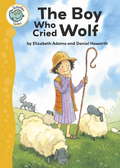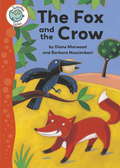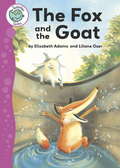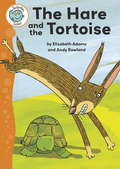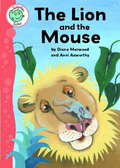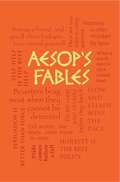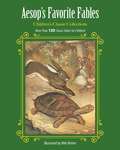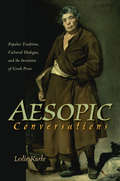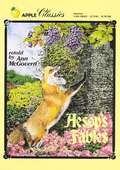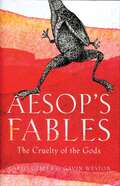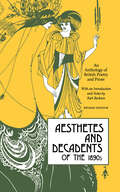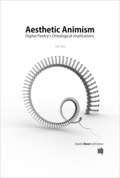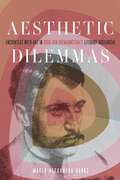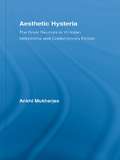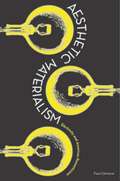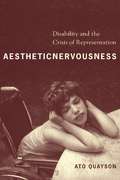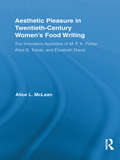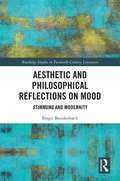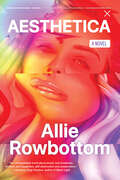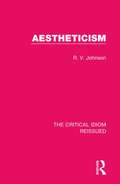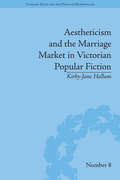- Table View
- List View
Aesop's Fables: The Boy Who Cried Wolf (Tadpoles Tales #14)
by Elizabeth AdamsA simple retelling of a favourite Aesop fable. Whenever the shepherd boy gets bored, he shouts, 'Wolf!' and everybody runs to help. But, one day, a real wolf comes ...
Aesop's Fables: The Fox and the Crow (Tadpoles Tales #15)
by Diane MarwoodA simple retelling of a favourite Aesop fable. Crow has some food, and Fox wants it! Can he think of a clever plan to make Crow drop the food?
Aesop's Fables: The Fox and the Crow (Tadpoles Tales)
by Diane Marwood Barbara NascimbeniA simple retelling of a favourite Aesop fable. Crow has some food, and Fox wants it! Can he think of a clever plan to make Crow drop the food?
Aesop's Fables: The Fox and the Goat (Tadpoles Tales #16)
by Elizabeth AdamsA simple retelling of a favourite Aesop fable. Fox is trapped in a well and he tricks Goat into joining him. But can he trick Goat again to get out?
Aesop's Fables: The Hare and the Tortoise (Tadpoles Tales #17)
by Elizabeth AdamsA simple retelling of a favourite Aesop fable. Hare thinks he is much quicker than Tortoise and never stops teasing her. But what will happen when they have a race?
Aesop's Fables: The Hare and the Tortoise (Tadpoles Tales)
by Elizabeth Adams Andy RowlandA simple retelling of a favourite Aesop fable. Hare thinks he is much quicker than Tortoise and never stops teasing her. But what will happen when they have a race?
Aesop's Fables: The Lion and the Mouse (Tadpoles Tales #18)
by Diane MarwoodA simple retelling of a favourite Aesop fable. Mouse is in big trouble when he wakes Lion up... but one day, Lion might need Mouse's help!
Aesop's Fables: Together With The Life Of Aesop - Primary Source Edition (Wordsworth Classics)
by AesopAesop was a slave and storyteller who lived in ancient Greece around 620-564 BC. No writings by him exist (if they ever existed at all), yet numerous stories and tales have been credited to him and have been shared through oral tradition throughout the world. Many of these use animals as the main characters to convey deeper meanings and morals that have become ingrained in our cultural--and personal--belief systems. For example, in "The Goatherd and the Goat" we learn that there is no use trying to hide what can't be hidden. In "The Ass and the Purchaser" we find that people are known by the company they keep. In "The Boys and the Frogs," one person's pleasure may be another person's pain. "The Dogs and the Fox" show how easy it is to kick a man when he's down. And misery loves company, as we see in "The Fox Without a Tail."
Aesop's Favorite Fables: More Than 130 Classic Fables for Children!
by Milo WinterRacehorse Publishing’s Children’s Classic Collections is a new series that offers readers timeless compilations of children’s literature. Handsomely packaged and affordable, this new series aims to revitalize these enchanting works and continue the tradition of sharing them with the next generation.Passed down for thousands of years, Aesop’s Fables is a collection of moral stories by the famed storyteller from ancient Greece. Reprinted and translated thousands of times over the past two millennia, this collection represents some of the most widely known and famous children’s literature. Many of these fables bestow human traits upon animal characters and place them in human situations to highlight desirable and less desirable traits. Their intent, through the telling of these tales, is to teach readers important moral lessons such as "Self-help is the best help” or "Do not attempt too much all at once.”Accompanied by beautiful color illustrations by renowned illustrator Milo Winter, this premiere collection of Aesop’s Favorite Fables is sure to ignite young imaginations and educate readers about virtue, kindness, integrity, problem-solving, happiness, and what it means to be human.
Aesopic Conversations
by Leslie KurkeExamining the figure of Aesop and the traditions surrounding him, Aesopic Conversations offers a portrait of what Greek popular culture might have looked like in the ancient world. What has survived from the literary record of antiquity is almost entirely the product of an elite of birth, wealth, and education, limiting our access to a fuller range of voices from the ancient past. This book, however, explores the anonymous Life of Aesop and offers a different set of perspectives. Leslie Kurke argues that the traditions surrounding this strange text, when read with and against the works of Greek high culture, allow us to reconstruct an ongoing conversation of "great" and "little" traditions spanning centuries.Evidence going back to the fifth century BCE suggests that Aesop participated in the practices of nonphilosophical wisdom (sophia) while challenging it from below, and Kurke traces Aesop's double relation to this wisdom tradition. She also looks at the hidden influence of Aesop in early Greek mimetic or narrative prose writings, focusing particularly on the Socratic dialogues of Plato and the Histories of Herodotus. Challenging conventional accounts of the invention of Greek prose and recognizing the problematic sociopolitics of humble prose fable, Kurke provides a new approach to the beginnings of prose narrative and what would ultimately become the novel.Delving into Aesop, his adventures, and his crafting of fables, Aesopic Conversations shows how this low, noncanonical figure was--unexpectedly--central to the construction of ancient Greek literature.
Aesop’s Fables
by Ann Mcgovern A. J. McclaskeySixty-seven familiar and not so familiar fables from Aesop, including the tortoise and the hare, the frogs who wanted a king, the lion who fell in love, and the donkey who danced on the roof.
Aesop’s Fables: The Cruelty of the Gods
by Carlo Gébler&“A welcome feast of fables for our times … Carlo Gébler&’s book is a wonderful, gloomy and welcome addition to the Aesopic corpus … The stories have been re-written in a spiky, contemporary style … The content of these pessimistic stories is thought-provoking but what makes the collection absolutely delightful is the vigor and originality of Carlo Gébler&’s writing. The illustrations by Gavin Weston are likewise magnificent.&” —The Irish Times &“This repackaging of [Aesop's] fables by Carlo Gebler and illsutrator Gavin Weston is a reminder that adult minds were originally the target of this litany of pocket-sized parables ... There is very much a feeling here of the ancient sound-tracking the alarmingly present.&” —Sunday Independent (Dublin) &“Scary new versions of ancient morality tales, Aesop's Fables, with stings in all their tails [...] are full of adult wisdom, human misfortune and bitter experiences, which, because they happen to other people, are hilarious.&” —Belfast TelegraphTHE GREATEST COLLECTION OF FABLES EVER WRITTEN, UPDATED FOR OUR TURBULENT TIMES A witty illustrated version of the world's greatest collection of fables, allegedly written by a slave in the 5th century BC. A book for our times: as Gebler notes, Aesop has two subjects—the exercise of power and the experience of the powerless who endure life and all that it inflicts on them. This retelling of the Fables makes them relevant and richly enjoyable. Large and fierce animals kill and butcher weaker creatures; gods play games with the hopes and fears of lesser species, including men and women; and occasionally the weak turn the tables on the strong, exposing their pretensions. This is a stunning new version of a book that was often bowdlerized and used to teach moral lessons to children. Gebler&’s Aesop is darker and more realistic, and compulsively readable.
Aesthetes and Decadents of the 1890s: An Anthology of British Poetry and Prose
by Karl BecksonThe Aesthetic and Decadent Movement of the late 19th century spawned the idea of "Art for Art's Sake," challenged aesthetic standards and shocked the bourgeosie. From Walter Pater's study, "The Renaissance to Salome, the truly decadent collaboration between Oscar Wilde and Aubrey Beardsley, Karl Beckson has chosen a full spectrum of works that chronicle the British artistic achievement of the 1890s. In this revised edition of a classic anthology, "The Ballad of Reading Gaol" has been included in its entirety; the bibliography has been completely updated; Professor Beckson's notes and commentary have been expanded from the first edition published in 1966. The so-called Decadent or Aesthetic period remains one of the most interesting in the history of the arts. The poetry and prose of such writers as Yeats, Wilde, Symons, Johnson, Dowson, Barlas, Pater and others are included in this collection, along with sixteen of Aubrey Beardsley's drawings.
Aesthetic Animism: Digital Poetry's Ontological Implications
by David Jhave JohnstonA poetics appropriate to the digital era that connects digital poetry to traditional poetry's concerns with being.This book offers a decoder for some of the new forms of poetry enabled by digital technology. Examining many of the strange technological vectors converging on language, it proposes a poetics appropriate to the digital era while connecting digital poetry to traditional poetry's concerns with being (a.k.a. ontological implications). Digital poetry, in this context, is not simply a descendent of the book. Digital poems are not necessarily “poems” or written by “poets”; they are found in ads, conceptual art, interactive displays, performative projects, games, or apps. Poetic tools include algorithms, browsers, social media, and data. Code blossoms into poetic objects and poetic proto-organisms.Introducing the terms TAVs (Textual-Audio-Visuals) and TAVITS (Textual-Audio-Visual-Interactive), Aesthetic Animism theorizes a relation between scientific method and literary analysis; considers the temporal implications of animation software; and links software studies to creative writing. Above all it introduces many examples of digital poetry within a playful yet considered flexible taxonomy. In the future imagined here, digital poets program, sculpt, and nourish immense immersive interfaces of semi-autonomous word ecosystems. Poetry, enhanced by code and animated by sensors, reengages themes active at the origin of poetry: animism, agency, consciousness. Digital poetry will be perceived as living, because it is living.
Aesthetic Dilemmas: Encounters with Art in Hugo von Hofmannsthal’s Literary Modernism
by Marlo Alexandra BurksHugo von Hofmannsthal (1874–1929) is frequently portrayed in cultural histories as an aloof writer with a precious style, out of step with modern sensibilities. In Aesthetic Dilemmas Marlo Burks reassesses Hofmannsthal’s oeuvre and its place in twentieth-century European modernist aesthetics.Through an examination of a diverse range of Hofmannsthal’s ekphrastic writings – including poetry, essays, opera libretti, fiction, and letters – Burks argues that Hofmannsthal’s work aims to engage the consciousness and sensibility of readers, listeners, and viewers by way of dynamic encounters with works of art. Aesthetic Dilemmas thereby corrects a long-standing, flawed characterization of Hofmannsthal’s work as escapist and demonstrates how his place in the Modernist movement has been misunderstood in most scholarship. The book is in dialogue with a broad range of critical voices and treats a variety of themes, from aestheticism to money, interpersonal relationships, suffering, poverty, labour, futurity, legacy, and hope. Translating numerous passages into English for the first time, Aesthetic Dilemmas gives English-speaking readers the chance to evaluate Hofmannsthal’s literary merit and his contributions to the enduring conversation about art’s relation to ethics.
Aesthetic Hysteria: The Great Neurosis in Victorian Melodrama and Contemporary Fiction (Literary Criticism and Cultural Theory)
by Ankhi MukherjeeAesthetic Hysteria is a deconstructive psychoanalytic study of hysteria, using literary texts to foreground a telling encounter between two growing discourses within English studies: that of emotion/affect and trauma studies. It brings together several academic foci - the history of medicine, aesthetic theory, speech act theory, feminism, and gender and performance studies. The study uses its theoretical and philosophical questioning of a cultural phenomenon to interrogate the politics and ends of theory, and is timely in addressing similar anxieties dominating contemporary critical and cultural theory.
Aesthetic Materialism
by Paul GilmoreWalt Whitman's "Sing the Body Electric" metaphor from his epic Leaves of Grass poem stems from the technology of the time, according to Gilmore (English, California State U. , Long Beach). After tracing the term "aesthetics" back to Elizabeth Peabody's Aesthetic Papers (1849), he analyzes aesthetic images of electricity, the telegraph, and other technological developments from earlier British Romanticism to those of American Romantic writers including Whitman, Herman Melville, and Frederick Douglass. Portions of the chapter on Douglass were originally printed in a 2002 issue of the literary journal ATQ. Annotation ©2009 Book News, Inc. , Portland, OR (booknews. com)
Aesthetic Nervousness: Disability and the Crisis of Representation
by Ato QuaysonFocusing primarily on the work of Samuel Beckett, Toni Morrison, Wole Soyinka, and J. M. Coetzee, Ato Quayson launches a thoroughly cross-cultural, interdisciplinary study of the representation of physical disability. Quayson suggests that the subliminal unease and moral panic invoked by the disabled is refracted within the structures of literature and literary discourse itself, a crisis he terms "aesthetic nervousness." The disabled reminds the able-bodied that the body is provisional and temporary and that normality is wrapped up in certain social frameworks. Quayson expands his argument by turning to Greek and Yoruba writings, African American and postcolonial literature, depictions of deformed characters in early modern England and the plays of Shakespeare, and children's films, among other texts. He considers how disability affects interpersonal relationships and forces the character and the reader to take an ethical standpoint, much like representations of violence, pain, and the sacred. The disabled are also used to represent social suffering, inadvertently obscuring their true hardships.
Aesthetic Pleasure in Twentieth-Century Women's Food Writing: The Innovative Appetites of M.F.K. Fisher, Alice B. Toklas, and Elizabeth David (Routledge Studies in Twentieth-Century Literature)
by Alice McLeanThis book explores the aesthetic pleasures of eating and writing in the lives of M. F. K. Fisher (1908-1992), Alice B. Toklas (1877-1967), and Elizabeth David (1913-1992). Growing up during a time when women's food writing was largely limited to the domestic cookbook, which helped to codify the guidelines of middle class domesticity, Fisher, Toklas, and David claimed the pleasures of gastronomy previously reserved for men. Articulating a language through which female desire is artfully and publicly sated, Fisher, Toklas, and David expanded women’s food writing beyond the domestic realm by pioneering forms of self-expression that celebrate female appetite for pleasure and for culinary adventure. In so doing, they illuminate the power of genre-bending food writing to transgress and reconfigure conventional gender ideologies. For these women, food encouraged a sensory engagement with their environment and a physical receptivity toward pleasure that engendered their creative aesthetic.
Aesthetic Poetry
by Walter PaterTHE "aesthetic" poetry is neither a mere reproduction of Greek or medieval poetry, nor only an idealisation of modern life and sentiment. <P> <P> The atmosphere on which its effect depends belongs to no simple form of poetry, no actual form of life. Greek poetry, medieval or modern poetry, projects, above the realities of its time, a world in which the forms of things are transfigured. Of that transfigured world this new poetry takes possession, and sublimates beyond it another still fainter and more spectral, which is literally an artificial or "earthly paradise."
Aesthetic and Philosophical Reflections on Mood: Stimmung and Modernity (Routledge Studies in Twentieth-Century Literature)
by Birgit BreidenbachThis study explores the concept of Stimmung in literary and philosophical texts of the modern age. Signifying both 'mood' and 'attunement', Stimmung speaks to the categories of affective experience and aesthetic design alike. The study locates itself in the nexus between discourses on modernity, existentialism and aesthetics and uncovers the pivotal role of Stimmung in 19th- and 20th-century European narrative fiction and continental philosophy. The study first explores the philosophical and aesthetic origins and implications of Stimmung to, then, discuss its role in the narrative fiction of three key authors of modern literature: Fyodor Dostoevsky, Samuel Beckett and Thomas Bernhard. These readings demonstrate a significant shift towards an aesthetic of affective intensity and immediacy, in which the experience of the reading process takes centre stage as each author develops an aesthetic philosophy of Stimmung in their own right. Through its focus on the concept of Stimmung, the study thus unearths a fundamental link between existentialist concerns and narrative practice in modern literature.
Aesthetica
by Allie RowbottomIn a debut novel as radiant as it is caustic, a former influencer confronts her past—and takes inventory of the damages that underpin the surface-glamour of social media.At 19, she was an Instagram celebrity. Now, at 35, she works behind the cosmetic counter at the &“black and white store,&” peddling anti-aging products to women seeking physical and spiritual transformation. She too is seeking rebirth. She&’s about to undergo the high-risk, elective surgery Aesthetica™, a procedure that will reverse all her past plastic surgery procedures, returning her, she hopes, to a truer self. Provided she survives the knife. But on the eve of the surgery, her traumatic past resurfaces when she is asked to participate in the public takedown of her former manager/boyfriend, who has rebranded himself as a paragon of &“woke&” masculinity in the post-#MeToo world. With the hours ticking down to her surgery, she must confront the ugly truth about her experiences on and off the Instagram grid. Propulsive, dark, and moving, Aesthetica is a Veronica for the age of &“Instagram face,&” delivering a fresh, nuanced examination of feminism, #MeToo, and mother-daughter relationships, all while confronting our collective addiction to followers, filters, and faux realities.
Aestheticism (The Critical Idiom Reissued #3)
by R. V. JohnsonFirst published in 1969, this work explores aestheticism and its relationship with literature. After defining the term and examining the unique qualities of ‘the Aesthetes’, the book provides an overview of the literary movement from its emergence to its apotheosis in the 1890s. This book will be of particular interest to those studying 19th Century literature.
Aestheticism and the Marriage Market in Victorian Popular Fiction: The Art of Female Beauty (Literary Texts and the Popular Marketplace #8)
by Kirby-Jane HallumBased on close readings of five Victorian novels, Hallum presents an original study of the interaction between popular fiction, the marriage market and the aesthetic movement. She uses the texts to trace the development of aestheticism, examining the differences between the authors, including their approach, style and gender.
Aesthetics
by Michael GandyThe attempt to put a big box store in the middle of an upscale development turns the town of Millicent, Mississippi, on its head, with opponents on both sides of the issue turning deadly.
